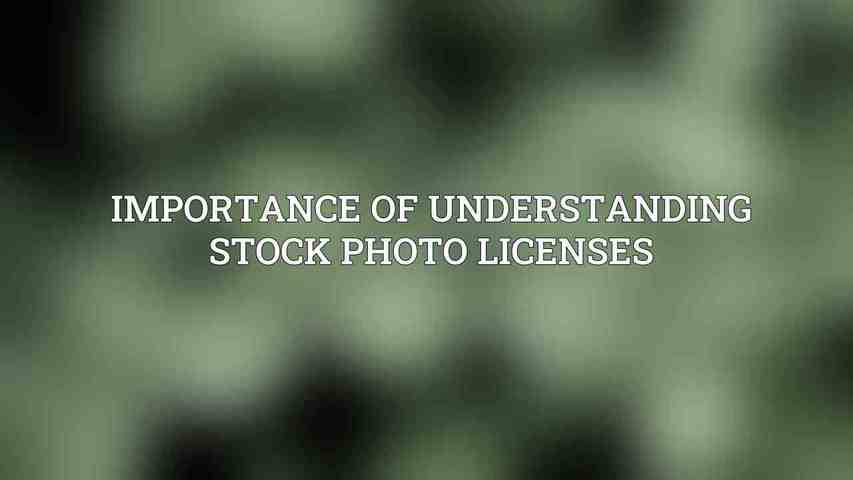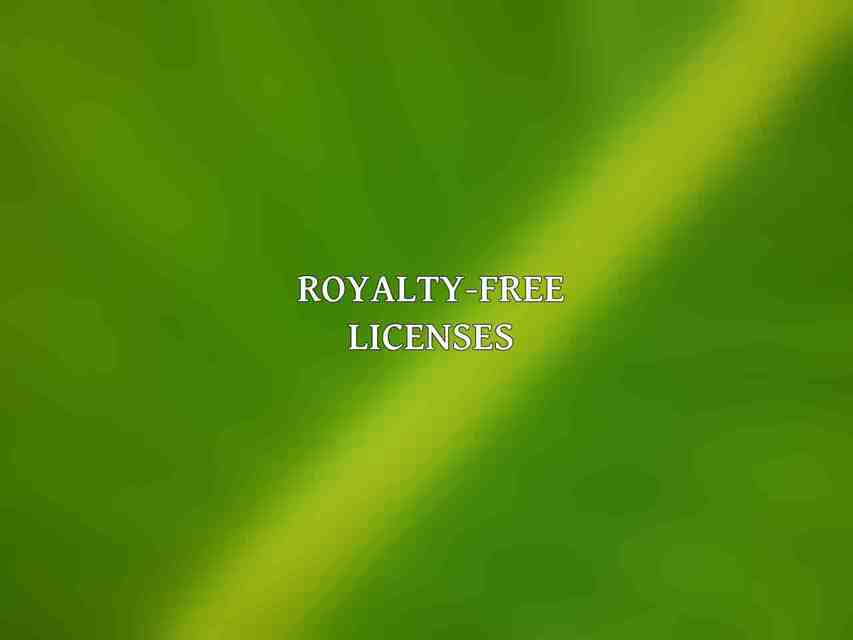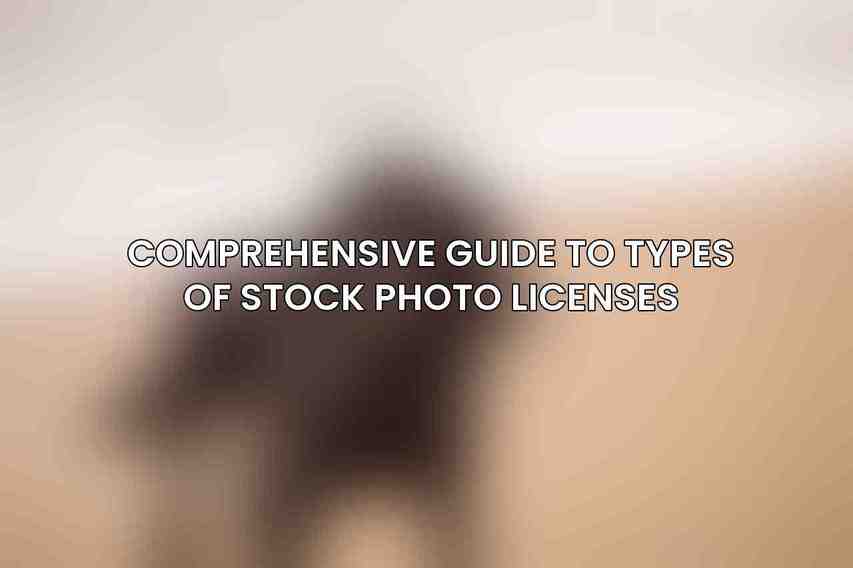determining how images can be used, shared, and distributed. Understanding the nuances of different types of stock photo licenses is essential for both content creators and consumers to avoid legal issues and ensure compliance with copyright regulations.
Importance of Understanding Stock Photo Licenses

Navigating the realm of stock photo licenses is vital in this digital age where images are widely used across various platforms for personal, commercial, and marketing purposes. Each type of license comes with its own set of rules, restrictions, and permissions that dictate how the image can be utilized. Failure to adhere to these license terms can result in copyright infringement, leading to legal repercussions.
Types of Stock Photo Licenses
Stock photo licenses can generally be categorized into three main types: Royalty-Free Licenses, Rights-Managed Licenses, and Extended Licenses. Each type offers different levels of usage rights, costs, and restrictions, catering to diverse needs and preferences of content creators and users.
Royalty-Free Licenses

Definition of Royalty-Free Licenses
Royalty-free licenses allow users to pay for the image once and use it multiple times without additional fees. This type of license offers convenience and cost-effectiveness for those who require flexibility in image usage. However, there are limitations to consider within this license structure.
Pay Once, Use Forever: Users pay a one-time fee to access and utilize the image indefinitely.
No Additional Fees per Use: Unlike some other license types, royalty-free licenses do not require additional payments based on the number of times the image is used.
Limitations of Royalty-Free Licenses
While royalty-free licenses offer convenience, there are restrictions that users must be aware of to ensure compliance with the license terms.
Restrictions on Usage: Some royalty-free licenses may limit the usage of images to either personal or commercial use, requiring separate licenses for each type of use.
May Have Restrictions on Editing: Certain royalty-free licenses may restrict or prohibit editing, modification, or alteration of the original image.
Types of Royalty-Free Licenses
there are variations that cater to different needs and purposes:
Standard Royalty-Free Licenses: Offer basic usage rights for a one-time fee.
Extended Royalty-Free Licenses: Provide additional benefits such as unlimited commercial use, but at a higher cost.
Examples of Royalty-Free Licenses
Some popular royalty-free licenses include:
Creative Commons Zero: A license that allows for maximum freedom of use without any restrictions.
Unsplash License: Known for its generous terms that permit widespread usage of images for various purposes.
Pexels License: Offers free access to high-quality images for personal and commercial use with attribution.
The flexibility and cost-effectiveness of royalty-free licenses make them a popular choice for many content creators across different industries.
Rights-Managed Licenses
Definition of Rights-Managed Licenses
Rights-managed licenses involve paying for each specific use of an image, granting limited rights based on the agreed terms. This type of license offers more control and exclusivity over how the image is used, but it comes with its own set of considerations.
Pay Per Use: Users are required to pay a fee each time they utilize the image for a new project or purpose.
specifying where and how the image can be used.
Advantages of Rights-Managed Licenses
Rights-managed licenses provide certain advantages that can be beneficial for those seeking greater control and exclusivity in their image usage:
Greater Control Over Usage: Content creators have more control over how, where, and when the image is used, ensuring it aligns with their branding and messaging.
Allows for Exclusive Usage Rights: Users can opt for exclusive rights to use an image for a specified period, preventing competitors from utilizing the same visuals.
Disadvantages of Rights-Managed Licenses
Despite the benefits, rights-managed licenses also come with drawbacks that users should be mindful of:
Can Be Expensive: The cost of rights-managed licenses can vary based on factors such as image quality, intended use, and exclusivity, making them a pricier option compared to other licenses.
Complex Terms and Conditions: The terms and conditions of rights-managed licenses can be intricate and may require careful attention to ensure compliance with the agreed-upon terms.
Examples of Rights-Managed Licenses
Well-known providers of rights-managed licenses include:
Getty Images: A leading source for premium, high-quality images with strict licensing terms.
iStockphoto: Offers a range of images with customizable licensing options to suit different user needs.
Shutterstock: Known for its vast library of images with diverse licensing options for commercial use.
Extended Licenses
Definition of Extended Licenses
Extended licenses combine elements of both royalty-free and rights-managed licenses, offering a middle ground in terms of flexibility and cost. While they provide more usage rights than royalty-free licenses, they may not offer the same level of protection or exclusivity as rights-managed licenses.
- Combination of Royalty-Free and Rights-Managed Licenses: Extended licenses bridge the gap between the two main license types, allowing for more flexibility in image usage.
Advantages of Extended Licenses
Users opt for extended licenses for various reasons, including:
More Flexible Usage Rights: Extended licenses offer broader permissions for image usage, allowing users to customize how the image is used within their projects.
Lower Cost Compared to Rights-Managed Licenses: While more expensive than standard royalty-free licenses, extended licenses are generally more affordable than rights-managed options.
Disadvantages of Extended Licenses
Despite their benefits, extended licenses come with certain limitations and considerations:
May Not Offer the Same Protection: Extended licenses may not provide the same level of legal protection or exclusivity as rights-managed licenses, leaving users vulnerable to potential misuse.
Restrictions on Usage: Some extended licenses may come with restrictions on usage, such as limitations based on geographic location or industry.
Examples of Extended Licenses
Popular platforms offering extended licenses include:
Adobe Stock: Known for its vast collection of high-quality images with flexible licensing options.
Depositphotos: Provides users with access to millions of images with customizable licensing agreements to suit various needs.
Pond5: Offers a diverse range of multimedia content with extended licensing options for commercial use.
The versatility of extended licenses makes them a favored choice for users who require more flexibility in image usage while maintaining a balance between cost and usage rights.
Choosing the Right License
Factors to Consider When Choosing a License
When selecting a stock photo license, several factors should be taken into account to ensure that it aligns with the intended use and requirements of the project:
Intended Use of the Image: Consider whether the image will be used for personal, commercial, or marketing purposes to determine the appropriate license type.
Budget: Evaluate the budget constraints and cost considerations associated with different types of licenses to find a suitable option.
Desired Level of Control Over Usage: Determine how much control and exclusivity are needed in the usage of the image to select the most appropriate license type.
Recommendations for Different Scenarios
Based on specific usage scenarios, different types of licenses are recommended:
For Commercial Use: Rights-managed or extended licenses offer greater control and flexibility for commercial projects that require exclusive image rights.
For Personal Use: Royalty-free licenses provide a cost-effective solution for individuals seeking images for personal blogs, websites, or projects.
For Social Media Use: Opt for a royalty-free license that includes social media rights to ensure compliance with platform regulations.
Importance of Reading License Agreements Carefully
Regardless of the chosen license type, it is crucial to carefully read and understand the terms of the license agreement. By being informed about the permissions, restrictions, and obligations outlined in the license, users can avoid potential legal issues and ensure proper usage of the images.
navigating the world of stock photo licenses requires a comprehensive understanding of the different types available and their implications on image usage. By familiarizing yourself with the nuances of royalty-free, rights-managed, and extended licenses, you can make informed decisions that align with your project’s needs and budget constraints. Choosing the right license is crucial in maintaining legal compliance and avoiding the consequences of using images without proper authorization.
By delving into the intricacies of stock photo licenses and exploring the various options available, content creators and users can navigate the digital realm with clarity and confidence, ensuring that their image usage is in full compliance with copyright regulations and license agreements.
Frequently Asked Questions
What is a stock photo license?
A stock photo license is a legal agreement between a photographer or a stock agency and a user that specifies the terms under which the user can use the photo.
What are the different types of stock photo licenses?
The main types of stock photo licenses include royalty-free, rights-managed, and editorial licenses.
What is a royalty-free license?
A royalty-free license allows the user to use the photo multiple times for a set fee without having to pay royalties each time the image is used.
What is a rights-managed license?
A rights-managed license is a one-time use license that requires the user to pay royalties each time they want to use the image for a different project or purpose.
What is an editorial license?
An editorial license allows the photo to be used in editorial content, such as news articles or educational materials, but not for commercial purposes like advertisements.

